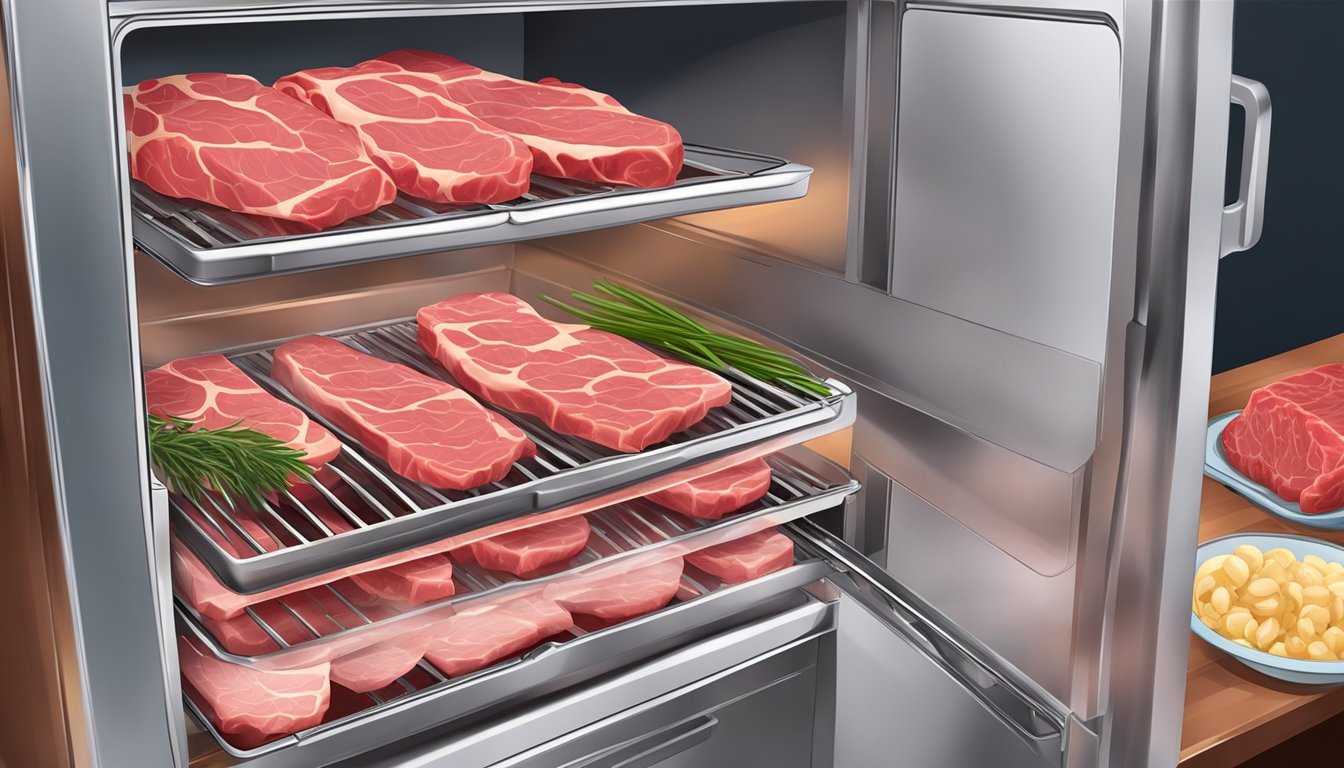How to Safely Store and Handle Raw Meat on the Carnivore Diet
Essential Tips for Food Safety
The carnivore diet emphasizes the consumption of animal products and typically excludes plant-based foods. It has gained popularity among those seeking various health benefits, including weight loss and reduced inflammation. A subset of this diet, the raw meat carnivore diet, includes exclusively raw animal products such as red meat (What wine goes well with red meat?), fatty fish, and sometimes certain dairy products. Those who follow this strict dietary regimen believe in the retention of more nutrients and enzymes that can be lost during cooking, although these claims require more scientific research to be substantiated.
When handling raw meat, food safety becomes paramount. Bacteria and other pathogens are more likely to be present in raw meat than in cooked meat, so proper storage and handling are essential to prevent foodborne illness. Storing raw meat on the bottom shelf of the refrigerator prevents juices from dripping and contaminating other foods. This should be coupled with thorough washing of hands and surfaces to eliminate any potential cross-contamination. Moreover, using separate utensils and cutting boards for raw meat can further reduce the risk of spreading harmful bacteria.
Understanding the Carnivore Diet
The carnivore diet is characterized by its exclusive focus on animal products and exclusion of plant-based foods, emphasizing high protein and zero carb intake. This section explores the fundamental principles and health considerations associated with adopting this diet.
Principles of the Carnivore Diet
The carnivore diet is grounded on the consumption of animal-based foods while eliminating carbohydrates fully. Its supporters argue that such a diet closely aligns with the eating habits of ancestral humans. The primary components of this diet include:
Meat: Including beef, pork, lamb, and other red meats, which serve as the main source of protein and nutrients.
Poultry: Chicken, turkey, and other fowl are also consumed for their protein content.
Fish: Highly valued for its omega-3 fatty acids, fish is a staple, especially varieties high in fat such as salmon.
Other animal products: Eggs, lard, and bone marrow are included for additional fat and micronutrients.
Health Considerations and Nutrient Focus
A diet rich in animal products can provide high levels of certain nutrients that are essential for health:
Protein: Crucial for muscle maintenance and overall body function.
Iron: Found in red meat; vital for blood health.
Vitamins: B vitamins, particularly B12, are abundant in meat and crucial for nerve function and energy.
However, the carnivore diet also poses potential risks due to its restrictive nature, including:
Increased risk of heart disease, obesity, diabetes, and kidney disease due to high saturated fat and cholesterol intake.
Possible deficiencies in fiber and certain vitamins, which could affect blood sugar levels and gut health.
Impact on chronic diseases and conditions such as allergies, arthritis, depression, and anxiety, which some anecdotal reports suggest may improve, but scientific evidence is not conclusive.
In summary, while the carnivore diet may lead to short-term weight loss and some health benefits, it is restrictive and can present significant health risks. Long-term effects of such a diet are not well researched, and those considering it should consult healthcare providers to ensure balanced nutrient intake and address any preexisting health conditions.
Importance of Meat Selection
When embarking on a carnivore diet, selecting the right meat is crucial, as it directly impacts health, taste, and safety. High-quality, fresh meat ensures optimal nutrient intake and reduces the risk of foodborne illnesses.
Choosing High-Quality Meat
High-quality meat is characterized by its source and processing methods. Grass-fed beef and free-range poultry are often superior in nutritional content compared to their grain-fed counterparts, offering higher levels of omega-3 fatty acids and vitamins. For those incorporating lamb into their diet, a grass-fed lamb shank is not only rich in flavor but also packs substantial nutrients.
To determine high-quality meat, consider the following criteria:
Source: Opt for meats from reputable sources that prioritize animal welfare and sustainable practices.
Certification: Look for certifications like organic or pasture-raised as indicators of quality.
Appearance: Meat should look fresh, devoid of excessive packaging or processing.
Identifying Fresh Meat
Freshness is imperative for flavor and safety. Fresh meat typically showcases:
Color: Vibrant natural colors, such as bright red for beef, pale pink for pork, and crimson for lamb shank.
Texture: Firm to the touch, not slimy or sticky.
Smell: A no strong or off-putting odors should be present.
Raw meat should be stored at temperatures below 40 °F (4.4 °C) and used within recommended timeframes to maintain freshness:
Beef, Pork, Lamb: Generally has a refrigerator shelf life of 3 to 5 days.
Ground Meat: should be used within 1 to 2 days.
By carefully curating meat selection based on quality and freshness, consumers can ensure the meats they consume are not only enjoyable but also safe and nutritious.
Safe Handling of Raw Meat
Handling raw meat with precision is critical to prevent the spread of foodborne illnesses. The focus is on stopping cross-contamination and ensuring all food preparation areas and hands are thoroughly cleaned.
Cross-Contamination Prevention
Cross-contamination occurs when bacteria or parasites from raw meat transfer to other foods, surfaces, or utensils. To prevent this:
Use separate cutting boards: Designate one cutting board strictly for raw meat and another for produce and cooked items.
Keep raw meat separate: Store raw meat away from other foods in the refrigerator, preferably on the lowest shelf to prevent drips.
Marinate safely: If marinating meat, do so in a sealed container and never reuse marinade from raw meat unless boiled first.
Maintaining Clean Surfaces and Hands
The handling of raw meat requires diligence in cleanliness to safeguard against bacteria such as Salmonella and E. coli:
Washing hands: Wash hands with warm water and soap for at least 20 seconds before and after handling raw meat.
Clean surfaces: After preparing raw meat, clean all surfaces with hot, soapy water or a disinfectant approved for food contact surfaces.
Proper utensils and equipment care: Ensure all utensils, plates, and equipment that have come in contact with raw meat are thoroughly washed before reuse.
Proper Storage Techniques
Proper storage techniques are vital for maintaining the safety and quality of raw meat in a carnivore diet. By adhering to specific refrigeration and freezing guidelines as well as sealing and packaging methods, one can ensure that their meat remains fresh and free from contamination.
Refrigeration and Freezing
Refrigeration is essential for preventing the growth of harmful bacteria. The temperature should be kept between 32°F and 40°F for beef and approximately 34°F for chicken and other poultry. To avoid spoiled meat, one should consume fresh beef, veal, and lamb within 3-5 days of refrigeration. For fresh pork, the refrigeration window narrows to 1-3 days. If the meat won't be consumed within these time frames, it's advisable to freeze it.
Freezing raw meat correctly extends its shelf life significantly. When freezing meat, it's crucial to:
Keep the freezer temperature at 0°F or lower to prevent bacterial growth.
Use properly sealed containers or freezer-safe bags to ward off freezer burn.
Label the meat with the date of freezing to track its storage duration.
Proper freezing can keep beef, pork, and lamb fresh for up to 12 months, depending on the cut, while ground meats may last for 3-4 months.
Sealing and Packaging
The way one seals and packages raw meat is another key element in storage safety. It prevents exposure to air, which can lead to spoilage and freezer burn in frozen meat.
Sealing: Always use airtight packaging, whether storing meat in the refrigerator or freezer.
Packaging: For refrigerated meat, one can use the original packaging if it is unopened and airtight, or transfer it to a resealable plastic bag. For freezing, the use of heavy-duty aluminum foil, freezer paper, or freezer-specific plastic bags is recommended.
To summarize, proper storage techniques including effective refrigeration and freezing, coupled with correct sealing and packaging methods, are indispensable for minimizing the risk of foodborne illness and keeping raw meat fresh on the carnivore diet.
Preparation and Cooking Methods
When following a carnivore diet, it’s essential to handle and cook meat properly to ensure that it is safe to consume. Preparing meat with care and cooking it to the appropriate temperatures are critical steps in this process.
Cooking to Safe Temperatures
The use of a food thermometer is crucial to verify that meat has reached a safe internal temperature which varies by type. Here are the recommended temperatures for different types of meat:
Beef, Pork, Lamb, Veal:
Steaks, chops, roasts: 145°F (62.8°C), followed by a 3-minute rest time.
(beef, pork, lamb, veal): 160°F (71.1°C).
Poultry:
Chicken, turkey (whole, pieces, or ground): 165°F (73.9°C).
By ensuring meat reaches these temperatures, pathogens such as salmonella and E. coli are destroyed, making the meat safe for consumption.
When it comes to meat thermometer online shopping is the way to go!
Different Cooking Techniques
Each cooking method can affect the flavor and texture of the meat. Here's an overview of some popular cooking techniques and considerations:
Grilling:
Provides a smoky flavor and is suitable for quick-cooking cuts like steaks and skewered meat. Always preheat the grill and cook at the right temperature.
Roasting:
Ideal for larger cuts requiring slow cooking. Roast in an oven preheated to the correct temperature, using a meat thermometer to judge doneness.
Boiling/Stewing:
Good for tougher cuts of meat, as the slow simmering tenderizes the meat over time. It’s important to maintain a steady simmer and avoid vigorous boiling.
Sous Vide:
Involves vacuum-sealing the meat and cooking it in a water bath at a precisely controlled temperature, often followed by a quick sear for flavor.
By applying these preparation and cooking methods, one ensures not only the safety of their meat but also its culinary quality.
Risks of Consuming Raw Meat
Consuming raw meat on the carnivore diet comes with significant risks due to the potential presence of foodborne illnesses, parasites, and chemical contaminants. Understanding these risks is essential for ensuring health and safety.
Foodborne Illnesses and Parasites
Foodborne illnesses are often caused by harmful bacteria such as Salmonella, E. coli, and Listeria. These bacteria can lead to serious health issues, including gastrointestinal distress and more severe conditions like kidney failure.
Common symptoms of bacterial contamination can include nausea, vomiting, abdominal cramps, and diarrhea.
Parasites, such as Toxoplasma gondii and Trichinella spiralis, can also reside in raw meat. Ingesting parasites can result in symptoms ranging from mild discomfort to life-threatening emergencies.
Prevention: Proper cooking to recommended temperatures kills most bacteria and parasites.
Chemical Contaminants in Meat
Chemical contaminants, including polycyclic aromatic hydrocarbons (PAHs) and heterocyclic amines (HCAs), are formed when meat is cooked at high temperatures, but certain chemicals can be present in raw meat due to environmental contamination or processing methods.
Processed meats may contain high levels of sodium, nitrates, and nitrites, which are associated with an increased risk of cancer.
Harmful chemicals can accumulate in the body and contribute to various health problems. It is crucial for consumers to be aware of the origins and handling of their meat to minimize exposure to these contaminants.
Trace minerals such as magnesium, zinc, and nutrients like saturated fat and cholesterol are naturally present in meat and are essential in moderation, but they do not negate the risks posed by harmful bacteria and chemical contaminants.
The key to enjoying the carnivore diet while minimizing risk is through informed and careful handling, storage, and preparation of raw meat.
Considerations for Specific Types of Meat
Each type of meat requires careful handling to maintain safety and quality. The carnivore diet emphasizes the consumption of animal products, and proper storage and handling become paramount to ensure that meats, such as beef, pork, lamb, poultry, and fish, contribute positively to digestion and overall health.
Handling Beef, Pork, and Lamb
Beef, pork, and lamb should be stored at temperatures below 40°F (4°C). They vary in density and fat content, which affects how they should be handled:
Beef: This red meat is versatile but should be handled with care to prevent bacterial contamination. Store beef cuts, including steaks and roasts, at the back of the refrigerator where it’s coldest.
Pork: Similarly, pork should be kept cold at all times before cooking. Fresh pork can be refrigerated for about 3-5 days.
Lamb Shank: Lamb shanks, being thicker cuts, require refrigeration and should be used within 3-5 days of purchase.
When handling these meats:
Always wash hands before and after touching the meat.
Store meats separately to prevent cross-contamination.
Use separate cutting boards and knives for these meats.
Poultry and Fish Specifics
Poultry and fish are more perishable and require specific attention:
Poultry: This includes chicken and turkey, which should be stored at a maximum temperature of 40°F (4°C). They are highly susceptible to bacteria like Salmonella and should not be washed before cooking to avoid spreading bacteria.
Fish: Fresh fish should be stored in a fridge at 32°F (0°C) and used within 1-2 days. Oily fish like salmon can last a bit longer. For sushi-grade fish, storage at the right temperature is crucial due to the risk of parasites.
Handling tips for poultry and fish:
They should be stored in leak-proof packaging to avoid drips and cross-contamination.
Always thaw these meats in the refrigerator or under cold water, never at room temperature.
Nutritional Aspects and Health Benefits
The carnivore diet, focused on the consumption of animal products, especially raw meat, is rich in essential nutrients and may contribute to health benefits when safely handled and stored. It emphasizes the intake of high-quality proteins, fats, and an array of vital micronutrients.
Digestive Health and Nutrient Retention
Raw meat contains natural enzymes that can aid in digestion. These enzymes, along with the nutrient profile of raw meat, help in the assimilation of vital compounds such as B vitamins and minerals like iron, potassium, and phosphorus. The presence of collagen in raw meat supports gut health and integrity, potentially mitigating issues like leaky gut syndrome.
Potential Impact on Chronic Diseases
Consuming nutrient-dense meat that's properly stored and prepared can have a positive impact on the management of chronic diseases. Meat is a valuable source of hem iron, which is highly bioavailable, as well as B vitamins, crucial for energy metabolism. These nutrients can help maintain optimal blood sugar levels and have been associated with a reduced risk of conditions such as obesity, heart disease, and type 2 diabetes.
Benefits of a Zero-Carb Lifestyle
A zero-carb lifestyle, like that of the carnivore diet, naturally eliminates sugars and starches, which can have various health benefits. Individuals may experience weight loss due to a reduction in calories from carbohydrates, along with stable blood sugar levels. This dietary approach can also contribute to the alleviation of inflammation-related conditions such as arthritis, as well as mental health conditions like depression and anxiety.
Conclusion
Adhering to safe storage and handling practices when implementing a raw meat carnivore diet is essential for health and well-being. By consistently keeping raw meats at or below 40°F (4°C) in the refrigerator and separating different types of meat, individuals can mitigate the risk of cross-contamination. Freezing meat not only extends its shelf life but also acts as an additional measure against bacterial growth.
Those following the diet should remain vigilant in practicing cleanliness when preparing their meals. One should utilize separate cutting boards for raw meat to avoid the transfer of bacteria to other foods, a crucial step for those who may share their living space with others not on the carnivore diet.
Moreover, it is vital for followers of the raw meat carnivore diet to recognize the responsibility involved in consuming a diet of this nature. While nutrient retention and potential benefits may seem attractive, these should be weighed against the risks of foodborne illnesses.
Key Takeaways:
Store raw meats at or below 40°F (4°C).
Separate different types of meats.
Freeze meats for long-term storage and safety.
Practice cleanliness and use separate utensils for meat preparation.
Weigh the benefits against potential risks of consuming raw meats.
The carnivore diet, centered on raw meat consumption, entails a rigorous discipline of safe food handling to maintain health. It requires an informed approach, emphasizing prevention strategies and proper storage techniques to enjoy the proposed benefits responsibly.










